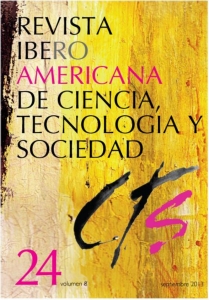Pervasiveness in software and IT services
methodological approach and an application to Brazil
DOI:
https://doi.org/10.52712/issn.1850-0013-631Keywords:
software activities, information technology services, uniquityAbstract
This paper aims to measure the activities of software and IT services performed outside the Brazilian software industry and to highlight the contribution of these activities to the competitive and innovative dynamics in several sectors. For this purpose, the authors used the methodological approach presented in another paper by Diegues and Roselino (2011). The study concludes that such activities are very significant and that the number of employees dedicated to the activities of software and IT services outside the software industry is larger than that allocated in the industry itself. It was also shown that these activities are concentrated in sectors as business services, public administrations and financial intermediations, among others. Regarding industry trends, the authors found that the secondary dimension of software and IT activities has been reducing its importance as part of the Brazilian software industry, which can be an indicator of an increased degree of maturity of this industry. Finally, the paper estimates that in 2008 the activities of software and IT service performed outside the software industry had a dimension of R$ 34.5 billion. That same year, the Brazilian software and related services industry showed a net operating revenue of R$ 47.4 billion.
Downloads
References
ARORA, A. e GAMBARDELLA, A. (2004): “The Globalization of The Software Industry: Perspectives and Opportunities for Developed and Developing Countries”, NBER Working Paper Series, Working Paper 10538.
BOSWORTH, B. e TRIPLETT, J. (2003): “Services Productivity in the United States: Griliches’ Services Volume Revisited”, paper prepared for CRIW Conference in Memory of Zvi Griliches, Brookings Institution, Washington DC.
COLECCHIA, A. e SCHREYER, P. (2001): “The impact of information communications technology on output growth”, STI Working Paper, OECD, Paris.
DIEGUES, A. C. (2010): Atividades de Software no Brasil: Dinâmica Concorrencial, Política Industrial e Desenvolvimento, Tese de Doutoramento, Instituto de Economia, Universidade Estadual de Campinas, Campinas.
DIEGUES, A. C. e ROSELINO, J. E. (2011): “Uma proposta metodológica para a mensuração das atividades de software realizadas fora da indústria de software”, Revista Brasileira de Inovação, vol. 10, nº 12, pp. 371-406.
FRANSMAN, M. (2001): “Evolution of the Telecommunications Industry into the Internet Age”. Disponível em: http://www.telecomvisions.com/articles/pdf/FransmanTelecomsHistory.pdf, acessado em 05/02/2010.
FRANSMAN, M. (2002): Telecom in the Internet Age: From Boom to Burst to…?, Oxford, Oxford University Press.
OECD (2004): The Economic Impact of ICT – Measurement, Evidence and Implications, Paris, OECD.
OECD (2007): “Classifying Information and Communication Technology (ICT) Services”, Working Party on Indicators for the Information Society, Paris, OECD.
OECD (2008): OECD Information Technology Outlook, Paris, OECD.
OECD (2009): Guide to Measuring Information Society, Paris.
OBSERVATÓRIO SOFTEX (2012): Software e serviços de TI: a indústria brasileira em perspectiva (vol. II), São Paulo, Softex.
PILAT, D. (2005): “The ICT Productivity Paradox: Insights from Micro Data”, OECD Economic Studies, nº 38, 2004/1, pp. 37-65.
SCHREYER, P.; BIGNON P. e DUPONT, J. (2003): “OECD Capital Services Estimates: Methodology and A First Set of Results”, OECD Statistics Working Paper, 2006/06.
STEINMUELLER, W. (1995): Technology Infrastructure in Information Technology Industries, MERIT - Maastrich Economic Research.
STEINMUELLER, W. (2004): “The European software sectoral system of innovation”, em F. MALERBA (ed.): Sectoral Systems of Innovation - Concepts, Issues and Analyses of Six Major Sectors in Europe, New York, Cambridge University Press.
VAN ARK, A.; TIMMER, M. e MULDER, N. (2003): ICT Investments and Growth Accounts for the European Union, 1980-2000, Groningen, Groningen Growth and Development Centre.
Downloads
Published
How to Cite
Issue
Section
License
Copyright (c) 2024 CC Attribution 4.0

This work is licensed under a Creative Commons Attribution 4.0 International License.
All CTS's issues and academic articles are under a CC-BY license.
Since 2007, CTS has provided open and free access to all its contents, including the complete archive of its quarterly edition and the different products presented in its electronic platform. This decision is based on the belief that offering free access to published materials helps to build a greater and better exchange of knowledge.
In turn, for the quarterly edition, CTS allows institutional and thematic repositories, as well as personal web pages, to self-archive articles in their post-print or editorial version, immediately after the publication of the final version of each issue and under the condition that a link to the original source will be incorporated into the self-archive.











